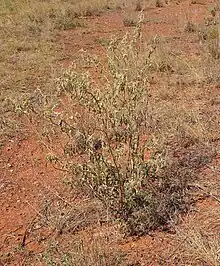Solanum chippendalei
[2]Solanum chippendalei (common names - solanum, bush tomato, ngaru, Chippendale's tomato)[3] is a small fruiting shrub in the family Solanaceae, native to northern Australia.[4] It is named after its discoverer, George Chippendale.[1][5] The fruits, known as "bush tomatoes", are edible and are an important indigenous food,[6] and the aborigines who use them broadcast the seed for later harvesting.[7]
| Solanum chippendalei | |
|---|---|
 | |
| Scientific classification | |
| Kingdom: | Plantae |
| Clade: | Tracheophytes |
| Clade: | Angiosperms |
| Clade: | Eudicots |
| Clade: | Asterids |
| Order: | Solanales |
| Family: | Solanaceae |
| Genus: | Solanum |
| Species: | S. chippendalei |
| Binomial name | |
| Solanum chippendalei Symon[1] | |
The species occurs in Western Australia, the Northern Territory and Queensland.[8][3][9]
Distribution
In Queensland it is found in the IBRA region of Mount Isa Inlier.[3]
In the Northern Territory it is found in the IBRA regions of: Burt Plain, Central Ranges, Davenport Murchison Ranges, Gibson Desert, Great Sandy Desert, MacDonnell Ranges, Ord Victoria Plain, and Tanami.[3]
In Western Australia it is found in the IBRA regions of:Central Ranges, Gascoyne, Gibson Desert, Great Sandy Desert, Little Sandy Desert, Pilbara, and Tanami.[4]
Habitat
S. chippendalei is found on spinifex-dominated rocky or gravelly rises, hills or ranges composed of neutral or acidic rocks, on Mulga-dominated red earth plains and on sandplains, and often in recently burnt areas and disturbed areas.[3]
Names
The many Indigenous names reflect both its importance[7] in the Central desert and the many language groups. They are:[3]
- Alyawarr: anaweyt, anemangkerr, kanakety
- Anmatyerr: anakety, antyewal
- Eastern Arrernte: *anaketye
- Jaru: rambaramba.
- Kaytetye: antyewarle, kanaketye, karnaketye, kwenemangkerre
- Pintupi Luritja: ngaru, pintalypa, pura
- Pitjantjatjara: ngaru, pintalypa, pura, wirkalpa
- Waramangu: nganjawarli
- Warlpiri: kakaja, ngaru, kurla-parnta, nganjawarli, ngayaki, wanakiji
- Western Arrernte: kwere
References
- "Solanum chippendalei". Australian Plant Name Index, IBIS database. Centre for Plant Biodiversity Research, Australian Government.
- Symon, D.E. (1981). "A revision of the genus Solanum in Australia". Journal of the Adelaide Botanic Gardens. 4: 272, figs. 119, 122.
- "NT Flora: Solanum chippendalei". eflora.nt.gov.au. Retrieved 2 September 2020.
- "Solanum chippendalei Symon". FloraBase. Western Australian Government Department of Biodiversity, Conservation and Attractions.
- Symon, D.E. (1981). "A revision of the genus Solanum in Australia" (PDF). Journal of the Adelaide Botanic Gardens. 4: 272, figs. 119, 122.
- "Solanum Chippendalei, Bush Tomato, Fruit". NUTTAB 2006 Online Version. Food Standards Australia New Zealand. Archived from the original on 30 July 2008.
- A.R. Bean & D.E. Albrecht (2008). "Solanum succosum A.R.Bean & Albr. (Solanaceae), a new species allied to S. chippendalei Symon". Austrobaileya. 7 (4): 669–675. doi:10.5962/p.299762. JSTOR 41739087. S2CID 260270739.
- D.E.Symon, R.W.Purdie (2020). "Solanum chippendalei". Flora of Australia. Canberra.: Australian Biological Resources Study, Department of Agriculture, Water and the Environment. Retrieved 3 September 2020.
- Western Australian Herbarium, Biodiversity and Conservation Science. "FloraBase—the Western Australian Flora: Solanum chippendalei". florabase.dpaw.wa.gov.au. Retrieved 2 September 2020.
External links
- "Solanum chippendalei Symon". Atlas of Living Australia.
- Solanum chippendalei occurrence data from the Australasian Virtual Herbarium